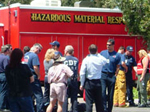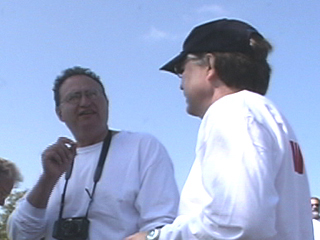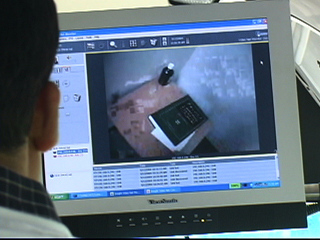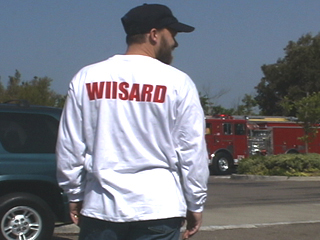Disaster Drill Tests New Wireless Technologies Developed at UCSD and Calit2
|
5.17.04 – The disaster began with the explosion of a simulated "dirty" bomb inside a Carlsbad office building. With that, one of the largest ever emergency response drills in San Diego County - dubbed Operation Moonlight - got underway May 12, to test preparedness among first responders and emergency-relief agencies. Within 90 minutes of the detonation, police and firefighters from around the county began arriving, including some that became victims requiring treatment as paramedics and hazardous materials crews arrived on the scene. Then, a second mock explosion went off in the parking lot - this one, a radiological bomb. At least 18 federal, state and local agencies participated, in addition to hospitals, Red Cross and county health and emergency systems, not to mention more than two dozen faculty, students and researchers from the UCSD Jacobs School of Engineering and California Institute for Telecommunications and Information Technology [Calit²].
|
The full-scale disaster drill was organized by San Diego's Metropolitan Medical Strike Team (MMST), and the contingent of researchers from UCSD and Calit² were on hand to learn how new technologies they are developing would operate in a real emergency-response situation. "We are working with the MMST to enhance their capabilities using wireless technology," said Leslie Lenert, a professor in the UCSD School of Medicine. "We are deeply indebted to the first-responder community for allowing us to take advantage of the drill to integrate ourselves with their activities and to learn more about how wireless systems work in this situation."
Lenert is the principal investigator on a $4 million project called Wireless Internet Information System for Medical Response in Disasters (WIISARD). Its goal: to develop and speed deployment of sophisticated wireless technology to coordinate and enhance care of mass casualties in a terrorist attack or natural disaster. The disaster drill coincided with a three-day site visit by WIISARD's funding agency, the National Library of Medicine, part of the National Institutes of Health.
Most of the new technologies tested during the drill came out of UCSD engineering labs and Calit², where WIISARD co-PI Ramesh Rao is the division director at UCSD. "This is a real-life drill, with real paramedics and first responders reacting to a simulated attack on the building," said Rao, who is also a professor of electrical and computer engineering at the Jacobs School. "We deployed a series of ad hoc systems and networks, and we got to see if those technologies are robust enough to work in such an environment. And they were."
|
Both Rao and Calit² director Larry Smarr were on hand for the disaster drill that involved more than 250 people from across the county. MMST officials including physician-director Theodore Chan (who is also an associate clinical professor of medicine at UCSD) pulled in a broad cross-section of first responders for the drill, including paramedics, Red Cross, fire, sheriff's deputies, police, SWAT teams and hazardous-materials crews from throughout San Diego County. At the same time, UCSD engineering faculty, researchers and students showcased several technologies developed for or adapted for use by WIISARD - underscoring the speed at which Calit² and the Jacobs School are pushing safety technologies out of the lab and into the field.
The day started with a tour of the CyberShuttle, which was used as a mobile command center. Developed by Calit² researchers, the CyberShuttle is a regular campus commuter bus outfitted with an 802.11b (Wi-Fi) local area network connected to a wide-area, third-generation (3G) cellular network recently launched by Verizon Wireless and based on QUALCOMM's 1xEVDO technology. The bus, which now displays computing and display capabilities, became the hub for wireless data transmission at the site, including victim tracking and vital-signs monitoring.
|
Researchers, and potential new industry partners, also set up an ad hoc, multi-hop 'mesh' video transmission network. Each camera was equipped with wireless, and each video feed was transmitted over the Wi-Fi network to the command center, and from there, to the Internet. The video gave emergency officials the ability to "see" the disaster site remotely, prior to dispatching hazmat and other crews to the scene. The video component is also under development by Ericsson engineer Rajesh Mishra as part of Rao's Always Best Connected project - and was not originally part of WIISARD - but "we didn't want to miss out on an opportunity to test this new idea," said Rao.
The hazmat team also tested a helmet-mounted camera on the system. "There is a hazmat person wearing a wireless camera and he's transmitting to our command center in the UCSD CyberShuttle," noted Lenert. "From there, paramedics can be in contact with the hazmat team, so they can be debriefed about the situation inside."
|
After SWAT and hazmat teams entered the building, they found more than a dozen "victims" - most of them, students in the Jacobs School's ECE 191 class working on a project supervised by Calit² principal development engineer Douglas Palmer. The class projects are designed to give engineering students hands-on experience in real-world electrical engineering. The students had good reason to volunteer for the disaster drill, because it would give them a close-up look at how the first responders used wireless technology that allowed the mobile command center to monitor continuously the vital signs of anyone "hurt" in the presumed attack.
|
The class started with a pulse oximeter built into a Pocket PC by Dolphin Medical. Pulse oximeters measure a patient's pulse as well as the level of oxygen in the blood via a clamp on the tip of a finger. For their part, Palmer's students incorporated Wi-Fi access into each of the devices. "The class is working on the signal processing, the wireless backhaul, and the processing subsystem required to get all this data back and collated," said Palmer. "Blood oxygen is one of the best indicators and predictors of patient health."
"What I told them is, 'you're a senior engineering student, and to experience what an engineer goes through, you have to be in the field to meet with the customer,'" added Palmer. "And in this case, the customer is the first-responder community."
The pulse oximeters as well as communications between first responders and the command center required high-speed Wi-Fi connectivity, which was provided by Entrée Wireless. The briefcase-sized devices each created a 1,000-ft. radius mobile 'bubble' of Wi-Fi access over the emergency area and channeled all the data to the Web over Verizon's 3G network (eliminating the need for each responder to carry a separate 3G device). Each bubble can support hundreds of victims and thirty or forty first responders. They also allow those responders communicating through one bubble to communicate with each other at about 5 megabits per second, with each bubble contributing 300K to 500K to an Internet connection depending on cellular coverage.
The test marked the first commercial deployment of Entrée's devices, as well as the first commercial product based on public-domain research done at Calit². "The original concept came from the CyberShuttle that they have on campus to allow students to have Wi-Fi access on the road to make some of their downtime more productive," said Entrée Wireless president David Ahlgren. "It allows you in a very economical way to bring communications to first responders."
|
The mobile Wi-Fi devices were also used for location-based tracking of patients - similar to the ActiveCampus Explorer technology developed by Jacobs School computer science and engineering professor Bill Griswold. Griswold directed research by WIISARD staffers Steve Brown and Ricky Huang to develop complex software systems for the ad hoc networks at the disaster scene. "Our team worked on the software to deliver the vital-signs and location tracking data to a server at UCSD and back out to command center software," said Griswold. "It allows first responders to keep track of how victims are doing and where they are located in targeted areas such as triage, decontamination, walking wounded, and the like."
|
"We have also tagged four first responders with GPS-enabled cell phones from Verizon and QUALCOMM," added Lenert. "We are testing the ability of that technology to monitor the positions of the first responders."
After a series of debriefings that began immediately following the drill, WIISARD researchers will work on improvements to the new technologies. They will also start work on the next phase of the project: a first-responder computer system. "We are going to try to give these guys situational awareness on a handheld device," said Lenert. "It would allow them to see the field, where the plumes are, where the victims are, and help them to organize better their own responsive care."
Related Links
WIISARD
Metropolitan Medical Strike Team
NIH National Library of Medicine
Jacobs School of Engineering
UCSD School of Medicine
Always Best Connected
ActiveCampus
ECE 191 Pulse Oximeter Project
Emergency Medical Services County of San Diego
Entrée Wireless
Verizon Wireless
QUALCOMM 1xEVDO
Dolphin Medical
City of San Diego Emergency Medical Services










